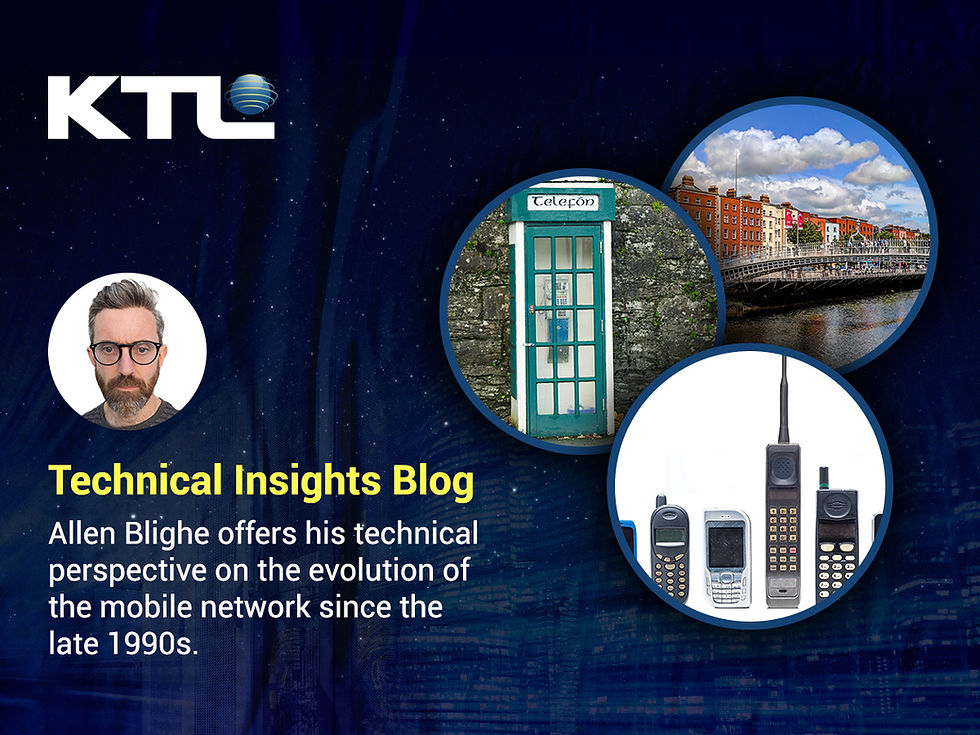KTL NOC Engineers
- KTL
- May 5, 2022
- 3 min read
Supporting operators with service availability and performance amid growing demand for mobile data

Demand for mobile services has grown rapidly in recent years according to a recent Ofcom report. This demand for mobile data will continue to grow as we rely on it increasingly to carry out daily activities like shopping, gaming, banking, and watching movies.

This demand is pushing operators, specifically at the Network Operation Centre (NOC), to upgrade and increase the RAN (radio access network) utilisation. A radio access network (RAN) is a major component of a wireless telecommunications system that connects individual devices to other parts of a network through a radio link.
KTL is a Transmission ASP (Application Service Provider) working with several leading network operators across Ireland and the UK - with long-standing experience and deep knowledge widely trusted in the industry.
Allen Blighe, KTL NOC Engineer, explained that operators are now facing various challenges including band saturation, tighter operational restrictions, rising energy costs, and growing supply chain issues. It also means growing RAN transmission (Tx) demands, and growing microwave capacity. Operators are also looking to scale their networks, which are becoming ever more complicated.
KTL’s flexible and agile approach is fundamental when delivering NOC PoV to our clients. “We use different network management systems (NMS’s) and support innovative technologies. We are also involved in scripting, automation and follow strict adherence to the change management process (out of hours work – late night, early morning, weekend),” said Blighe.
With experience that is second to none and access to the right tools and proven experience, KTL NOC Engineers provide:
Full turn-key network rollouts
New microwave link installation and commissioning
Reroute jobs for the RAN change team
Decommissioning and redeployment to reuse and/or utilise existing equipment
Perform troubleshooting and incident response on the systems
Track issues through to resolution
Communicate closely with operators site technicians or third parties responsible for the resolution
Ray Reilly, KTL NOC Engineer, said, “We are central to various departments including the project, technical, delivery, and change management teams. Our aim is always to build enduring relationships with SLS (Second Line Support), operations, and the incident teams; which is imperative in keeping a client’s project up and running. We act as a trusted go-between to ensure that ultimately project delivery is achieved.”
Blighe shared an example of troubleshooting and incident response, “We experienced several faults with a corporate client, which has two headquarters – one in Dublin and a second in a rural Irish location. On several occasions, the microwave links’ signal strength dropped to unusable levels and their services went down across both locations. The weather was good on each occasion, so this was ruled out.
“The rural fault turned out to be a tipper truck raising its trailer frequently to drop gravel on road works blocking the line of sight (LoS). The urban fault turned out to be contractors repairing the roof and wandering in front of the link blocking the LoS. This example illustrates that if a microwave radio link drops suddenly, it’s often a LoS issue at the customer site, so this is something we will always check.”
When asked about the future, Reilly said, “Contrary to previous industry predictions I think the requirement for microwave radio will still be huge. We have already deployed 10GB/s radios on the network between hub sites, which is a much cheaper and easier solution than fibre, certainly for resilience, back-up and secondary network routes.”
While Blighe believes the NOC role is “blurring into other roles” such as Field Engineering (who are gradually doing more configuration work traditionally associated with NOC Engineering), there is an evolution of the role into IP engineering and change management alongside transmission planning.
To find out more contact us today.




Comments